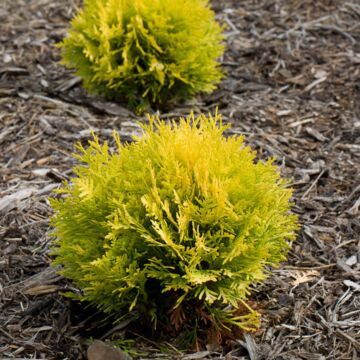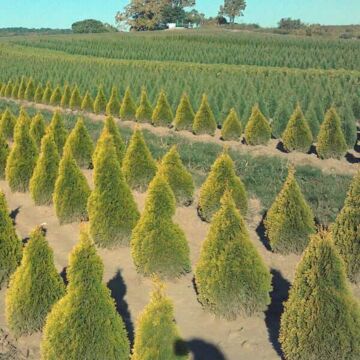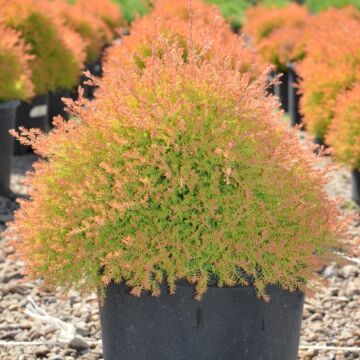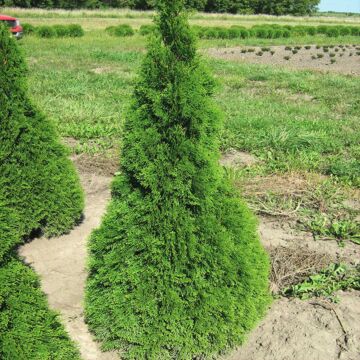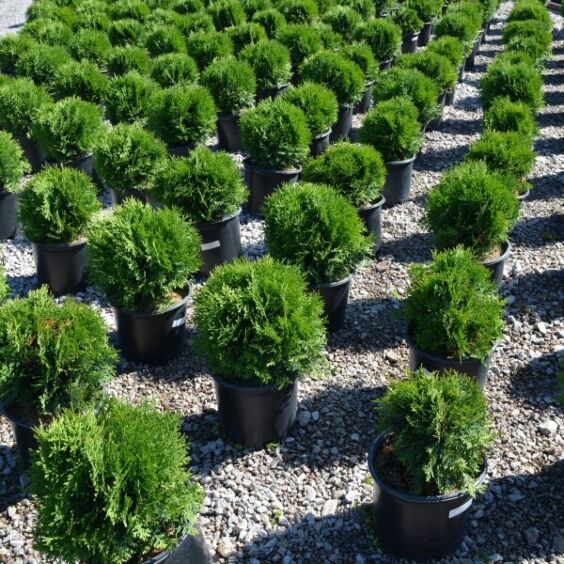
Growing zones
See Zone Map >Status: In stock
The Little Giant Arborvitae grows to a modest 4-5' tall and 3-5' wide, making it perfect for small rock gardens, foundation plantings, and even container gardening. This wonderful foundation plant fits any tight spot that needs a touch of evergreen elegance.
Unlike those fair-weather friends in your garden, the Little Giant Arborvitae brings year-round beauty. This little gem has rich green foliage that remains vibrant even in winter months, adding a touch of life to your landscape when many other plants have gone dormant.
Whether brightening up rock gardens, creating low hedges, or serving as a standout specimen, this dwarf arborvitae does it all.
Please note: #5 containers cannot be shipped to Arizona, California, Idaho, Montana, Nevada, Oregon, Utah, or Washington due to size restrictions.
Timeless Elegance Expertly Cultivated for Over 125 Years Add charm and structure to your garden with Little Giant Arborvitae from McKay Nursery. Our employee-owned company has been perfecting the art of plant cultivation for 125 years, ensuring you get the best quality and care. This compact, evergreen beauty is perfect for small gardens, foundation plantings, and containers. Don’t miss out on this low-maintenance gem that stays vibrant year-round. Trust McKay Nursery’s century-plus expertise to bring your landscape dreams to life.
Order yours today and see the difference. For more information, contact us at [email protected] or call us at 920-478-2121.
- Sun, Part Sun/Shade
Mature Plant Size (H x W): 4-5' x 3-5'
- Attracts Birds
- Winter Interest
- Walnut Toxicity Resistant
- Cut Flower
Planting & Care for Little Giant Globe Arborvitae (Thuja Occidentalis Little Giant)
Preparation
- The Little Giant Globe Arborvitae is an extremely hardy dwarf globe Arborvitae.
- Showcases solid dark-green foliage that rarely needs pruning to retain its shape.
- The Little Giant Arborvitae prefers well-drained soil and does best in full sun.
- Thuja occidentalis little giant grows very slowly.
- Excellent for rock gardens and foundation plantings.
- Matures to be around 4-5' tall x 4-5' wide.
Opening Plant Material
- Containers: Completely saturate all container plants by putting them in a larger water container until they stop bubbling; remove after. Now, ready to plant. Dig a hole no deeper than the depth of the container and 6" or more, ensuring it’s wider on the sides.
Planting containers
- Slide the plant from the pot by tapping on the bottom of the pot.
- Trim the bottom 2" off the root ball for plants with a shovel or knife in plastic containers.
- Rotate the Little Giant Arborvitae to the proper position. Never lift or move plants by the tops.
- Place the root ball in the hole.
- Notice where the base of the trunk flares out from the tree. This is called the root flare. This root flare should show when the tree is planted. If necessary, add soil under the ball to expose the root flare.
- Place fertilizer packets into the bottom of the hole (if purchased). *Use Our Recommended Fertilizer.
- Backfill the hole with soil, ensuring the top of the root ball is visible and slightly higher than the soil around it.
- Firm the soil around the plant. Water well to settle soil around the root ball.
Pruning - After Planting
- Containers: Although it is not essential for containers to be pruned after planting, light pruning for shape, to remove any broken branches from shipping, or to thin out a heavily branched plant will help in the transplanting process and the appearance of your new planting.
Pruning - Throughout the Season
-
Due to its slow growth rate and naturally rounded shape, Little Giant Arborvitae typically requires minimal to light annual pruning, not necessarily throughout the season. Late spring (around the end of June) is often recommended as a good time for this yearly light pruning. This allows for some new growth to be present while still encouraging bushier growth.
Watering - After Planting
- Plants typically take approximately 6 weeks to establish new roots in your soil. During this period, water plants as often as every 2-4 days at the start and at least a minimum of once per week.
- Beyond the 6-week establishment period, water is used once per week unless rain occurs.
- Stick your finger into the soil around 3” to check soil moisture.
Watering - Through-out the Season
- After the first season, Little Giant Arborvitae should only be watered during extended periods without rain.
- How do you know if your plants need water? The easiest way to tell is to touch the soil around the roots. If it is moist, there is no need to water. If dry, give it a good soak with the hose end (no nozzle), watering the soil only, not the leaves.
- Stick your finger into the soil around 3” to check soil moisture.
Frequently Asked Questions
What is the downside of Little Giant Arborvitae?
What diseases are Little Giant Globe Arborvitae susceptible to?
Leaf blight causes browning and dying of the foliage, often beginning at the tips. Canker involves the formation of sunken, dead areas on the branches, which can girdle and kill affected limbs. Ensuring proper soil pH and avoiding waterlogged conditions can help mitigate these issues.
What is the shortest Arborvitae?
How do I propagate Little Giant Globe Arborvitae?
Keep the cutting moist and provide indirect light until roots develop, which can take several weeks. Proper humidity and temperature control are crucial for successful propagation. Early spring is also a good time to check on the progress of the previous year's cuttings.
What is the ideal spacing for planting Little Giant Globe Arborvitae?
When planting in mixed plantings, consider the mature size of Little Giant Arborvitae to ensure compatibility with surrounding plants. Properly spacing these plants also helps maintain the integrity of their root systems and overall health.
Planting & Handling Help
Download our Planting and Handling Guide below to plan for a successful arrival and install of your plants. Be sure to water all plants as soon as they arrive and every day until you’re ready to plant. Keep any bare root bundles in a shady, cool spot with the roots covered at all times.


Learn More
Watch our videos on handling bare root plants, how your order is prepared for shipment and more.


Plant Sizing
What is the difference between Containers, Grow Bags, Bare Root, and Balled & Burlap (B&B)?
Shipping Times


Our FedEx and local shipping times depend on two factors, one is by the region and the second is the type of product being shipped. For example, small fruits are only shipped in spring, but majority of our perennials are shipped from spring until fall. Keep in mind the dates below act as a general guide. Due to unpredictable weather, staffing, inventory and industry demands these timelines can change. Therefore, we cannot guarantee any of these times.
Shipping Dates by Region*
Northern Cold Region: April 22nd - November 7th
Northern Region: April 15th - November 7th
Middle Region: April 1st - November 7th
Southern Region: March 15th - November 7th
Local Delivery (small radius from Waterloo, WI): April 22nd - November 7th
Shipping Dates by Season*
Spring Shipping: Region Start Date (above) - May
Fall Shipping: September - November
Due to unpredictable weather, these times may vary. Some varieties are exceptions due to heat and plant health reasons. Enter your shipping zip code at the top of this page and be sure to check the shipping information on each product before you add it to your cart. If the product is too large or restricted in your state, you will not be able to checkout with that item in your cart.

